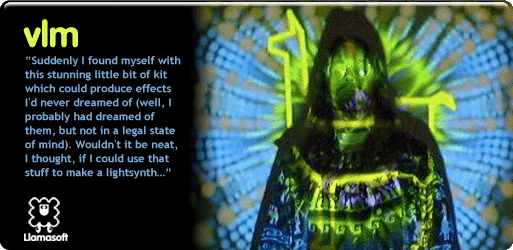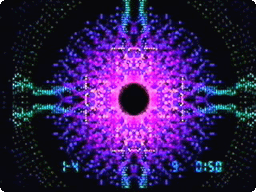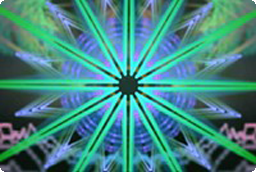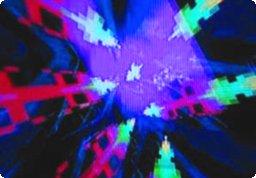VLM

Developed: 1990
VLM-0
One day I got a phone call from a couple of engineers working at Inmos, the UK firm responsible for the Transputer, one of the first commercially available CPUs intended for parallel computing. They had been thinking about making some kind of realtime graphics generator to accompany music, and then had been surprised and impressed when they stumbled across Trip-a-Tron, so called me to ask if I'd be interested in doing some work on Transputer hardware. This appealed to me and in due course they came to visit and installed a Tranny system in my PC.
I taught myself OCCAM-2 and within a few weeks had VLM-0 running. VLM-0 ("VLM" stood for "Virtual Light Machine") was more like what these days would be called a "visualizer", in that it was primarily driven by an external audio input rather than an operator "playing" it. It employed a number of different algorithms for interpreting the audio stream, primarily using particle systems, polygons and splines. It was quite simple but also pretty effective, and also the cause of my introduction to "rave culture" as we used it to provide projected visuals at many parties and raves. At various times it got used to provide visuals in the concerts of a few bands including the Shamen, Primal Scream and The Orb. I was even summoned to Paisley Park to demonstrate it in person to Prince! It was really quite odd seeing his famous yellow curly guitar plugged into my knackered old 286! };-D
VLM-0 was never commercially sold in any form, but we did have fun doing gigs and parties with it. I regret that I don't have any videos of it in operation for the archive... maybe if I chase up one of the Inmos guys there might be some...
Released: 1994
VLM-1
 When I'd been working on the Jaguar creating the game "Tempest 2000", I had discovered a truly wonderful technique, namely that of "feedback" - where basically you let the first thing drawn in a new frame be a *copy* of the previous frame, slightly modified. This served wonderfully to "amplify" even tiny bits of graphics and motion drawn on the screen, turning them into the most amazing swirling, fractal-looking displays. By varying the intensity you could make objects look like they were emitting coloured smoke. It was simply extraordinary stuff, and although I did use it in the game, the main usage I had in mind for it was to develop a lightsynth around it.
When I'd been working on the Jaguar creating the game "Tempest 2000", I had discovered a truly wonderful technique, namely that of "feedback" - where basically you let the first thing drawn in a new frame be a *copy* of the previous frame, slightly modified. This served wonderfully to "amplify" even tiny bits of graphics and motion drawn on the screen, turning them into the most amazing swirling, fractal-looking displays. By varying the intensity you could make objects look like they were emitting coloured smoke. It was simply extraordinary stuff, and although I did use it in the game, the main usage I had in mind for it was to develop a lightsynth around it.
Atari were in the process of developing a CD-ROM add-on for the Jaguar, and me and Ian Bennett, one of the Inmos guys, flew out to Sunnyvale to pitch them the idea of building a VLM implementation into the CD-ROM's firmware, to be invoked whenever the user played an audio CD. I was in particularly good favour at Atari, since "Tempest 2000" had been released to a degree of critical approval, and we got the green light to develop VLM for the add-on. It took about six months to make, with me doing all the graphical stuff and Ian writing the code to sample the audio stream and generate a frequency spectrum analysis which I then used to drive the visuals. The results were very pleasing - I have vivid memories of going into the office in Sunnyvale when we were out there finishing off the code, and finding Leonard Tramiel playing classical music through it and dancing ecstatically around my cube }:-).
A while after this was released, other "visualisers" started to appear on the PC, and at one time I was at a computer show in the US and one of the guys from Nullsoft came up to me and apologised for "borrowing" the techniques I'd used on the Jaguar VLM for their own visualisations }:-). And, in fact, to this day much of the visualisation stuff that you see in the likes of Winamp, Windows Media Player and iTunes uses fundamentally the same technique - using feedback to amplify small source input dynamics - that I used in VLM-1.
Sadly the Jaguar CD-ROM unit never sold that well, coming as it did towards the end of the Jaguar's life. I had thought that by getting the VLM into the very system firmware of a device, I would ensure that my lightsynth would reach a massive audience. Unfortunately this didn't turn out to be the case, and the CD-ROM unit, and thus VLM-1, is something of a rarity.
Released: 2000
VLM-2
 With the demise of Atari, I became involved with a company founded by some ex-Atari engineers to develop a media processor called NUON. This was a chip that contained an array of custom VLIW processor elements, intended to be used in DVD players to perform MPEG-2 decoding duties, with the added benefit that, as a general-purpose CPU rather than a hardwired device, players equipped with the chip would also be able to perform other duties, such as playing games. Coming from Atari, my history with VLM-1 was well known, so it was a natural thing for me to do a VLM for Nuon too.
With the demise of Atari, I became involved with a company founded by some ex-Atari engineers to develop a media processor called NUON. This was a chip that contained an array of custom VLIW processor elements, intended to be used in DVD players to perform MPEG-2 decoding duties, with the added benefit that, as a general-purpose CPU rather than a hardwired device, players equipped with the chip would also be able to perform other duties, such as playing games. Coming from Atari, my history with VLM-1 was well known, so it was a natural thing for me to do a VLM for Nuon too.
Those VLIW cores gave Nuon sufficient power that for the first time I had what I guess you could call "computational resolution" in the display. You have physical resolution (X by Y pixels), colour resolution (bit-depth), and "computational resolution" being the amount of maths you can actually afford to lavish on each and every pixel without slowing down the display. Before, when making effects it was all you could hope for to be able to throw bits around the display quickly, but now you could not only throw stuff around, you could perform significant computation on it at the same time. This allowed me to develop new techniques for VLM-2, and to refine existing ones - my feedback on VLM-2 was much more gentle and smoky than it could ever be on the VLM-1. In fact my guiding aesthetic for VLM-2 was "no visible pixels" - I wanted everything to blend together so well that you never saw a jagged edge or anything that actually gave away the fact that there were pixels underlying everything.
By and large I think I succeeded in that, especially as, due to changes in how much CPU I was granted during VLM operation, I had to scale back and redesign the whole thing in a period of about five weeks, and... well, you can project the thing on a 6 foot screen and still not see the pixels.
Ask me what rez it runs at, one day };-).
NUON chips were taken up by Toshiba and Samsung for some of their DVD players, and once again I thought getting into the firmware of a popular item of consumer electronics would at last bring one of my lightsynths to a genuinely broad audience - but once again it was not to be. The Nuon media processor never really took off, and after a handful of obscure DVD players featuring it trickled out - it was never even officially sold in the UK - Nuon quietly died. VLM-2 is probably even rarer than VLM-1.
I remember being absolutely gutted when I saw Apple advertising the iMac on telly, showing it running the iTunes visualizer. There was something running using substantially the same techniques as VLM-1, and the first time I'd ever seen such a thing rated highly enough to be shown on telly as a cool feature... but it wasn't mine. I felt like somehow despite all the years of work, I'd let my own creation down.
Developed: 2003 (Unreleased)
VLM-3
 In the Unity project, one of the fundamental ideas was that I would use lightsynth-style techniques to generate abstract environments and textures for use in the game. VLM-3 came about all in a rush, in just a few weeks, when my producer at Lionhead said to me one day "Jeff, I've got you booked to do the visuals at the Warp Records Christmas Rave". I kinda went "Eep!" and got my coding boots on quick smart because at that stage I had nothing that would really be usable and there wasn't that much time to prepare!
In the Unity project, one of the fundamental ideas was that I would use lightsynth-style techniques to generate abstract environments and textures for use in the game. VLM-3 came about all in a rush, in just a few weeks, when my producer at Lionhead said to me one day "Jeff, I've got you booked to do the visuals at the Warp Records Christmas Rave". I kinda went "Eep!" and got my coding boots on quick smart because at that stage I had nothing that would really be usable and there wasn't that much time to prepare!
With VLM-3 I returned to my roots, and made a completely user-performed light synthesiser, rather than the primarily audio-driven "visualizer"style of VLMs 0, 1 and 2. The Gamecube's fast 3D hardware enabled me to take effects generation out of a strictly 2D plane, as it had always been before, and enabled me to map it onto 3D environments. The major innovation of VLM-3 was that I made the lightsynth *multi-user* - for the first time a group of people could work together to orchestrate and create the display.
A couple of mates came to visit one weekend, and we were sitting around and talking and they asked to see what I was working on. It was still really early days at that point and all I had was a single effect controllable by two users. I genuinely thought it'd only be good for a quick 5-minute viewing, but nonetheless I fired up the projector and put it on, along with some tunes.
We didn't stop for nine hours. };-D
A month later - I still have the dates noted on my whiteboard - the guys came down again and we had the first ever 4-user VLM-3 session. It was the start of an excellent few months. Performing *as a Crew* was an experience that I had no idea would feel as good as it actually did. A week later, the Crew gathered in London for the Warp rave - and blew the roof off the club. People told us that it was the best set of visuals they'd ever seen.
Over the following year VLM-3 became more refined - I intended for it not only to generate textures and environments for Unity, but also to be unlockable in the game as a usable lightsynth in its own right. Maybe in this way my lightsynth would at last reach a reasonable-sized audience... but again, it was not to be. In the end the Unity project was cancelled and VLM-3, despite having given us so much enjoyment, and brought together a bunch of friends into the world's first ever realtime visuals performance crew, was dead.
But...
If you work hard, and you truly believe in something, then dreams can come true. The phoenix can rise from the ashes. And oh my, how brightly, and how far, is it risen...
Platforms
- VLM-1: Atari Jaguar
- VLM-2: Nuon
- VLM-0: Transputer
- VLM-3: Game Cube













